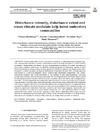Please use this identifier to cite or link to this item:
https://accedacris.ulpgc.es/handle/10553/74836
| Title: | Disturbance intensity, disturbance extent and ocean climate modulate kelp forest understory communities | Authors: | Wernberg, Thomas Couraudon-Réale, Marine Tuya, Fernando Thomsen, Mads |
UNESCO Clasification: | 241705 Biología marina 251001 Oceanografía biológica |
Keywords: | Disturbance Ecklonia Radiata Facilitation Functional Groups Ocean Climate, et al |
Issue Date: | 2020 | Journal: | Marine Ecology - Progress Series | Abstract: | Disturbances often control community structure by removing large dominant species, allowing new species to colonize. Disturbances vary in intensity and extent, and their effects on resident communities can depend on local environmental conditions. We tested the effects of disturbance intensity and extent on different functional groups of understory species in kelp forests at 4 locations along an ocean climate gradient in Western Australia. We hypothesized that, compared to intact canopies, increasing disturbance intensities (50 and 100% of kelp removal) and extents (2, 4 and 8 m diameter) would promote light-dependent competitors (turf, foliose, articulated coralline and fucoid seaweeds) at the expense of less light-dependent functional groups (invertebrates and encrusting seaweeds). We also hypothesized that these effects would be most pronounced at warmer relative to cooler locations, where metabolic and ecological rates are faster. The first hypothesis was supported; light-dependent understory groups (turfs, in particular) increased, while less light-dependent groups (crusts in particular) decreased with increasing disturbance regimes. However, the second hypothesis was not supported; even though understory communities differed between locations and turf covers were highest at the warmest location, we found no significant interactions between locations and disturbance regimes. Importantly, our results revealed that even small-scale partial canopy loss can have significant effects on kelp-associated communities. The implied community-wide, density-dependent effects have implications for the management and conservation of kelp forests, because restoration of ecological functions must also consider the density of kelp forests, not simply their presence or absence. | URI: | https://accedacris.ulpgc.es/handle/10553/74836 | ISSN: | 0171-8630 | DOI: | 10.3354/meps13443 | Source: | Marine Ecology Progress Series [ISSN 0171-8630], v. 651, p. 57-69, (Octubre 2020) |
| Appears in Collections: | Artículos |
SCOPUSTM
Citations
19
checked on Jun 8, 2025
WEB OF SCIENCETM
Citations
19
checked on Jun 8, 2025
Page view(s)
78
checked on May 23, 2024
Download(s)
82
checked on May 23, 2024
Google ScholarTM
Check
Altmetric
Share
Export metadata
Items in accedaCRIS are protected by copyright, with all rights reserved, unless otherwise indicated.
